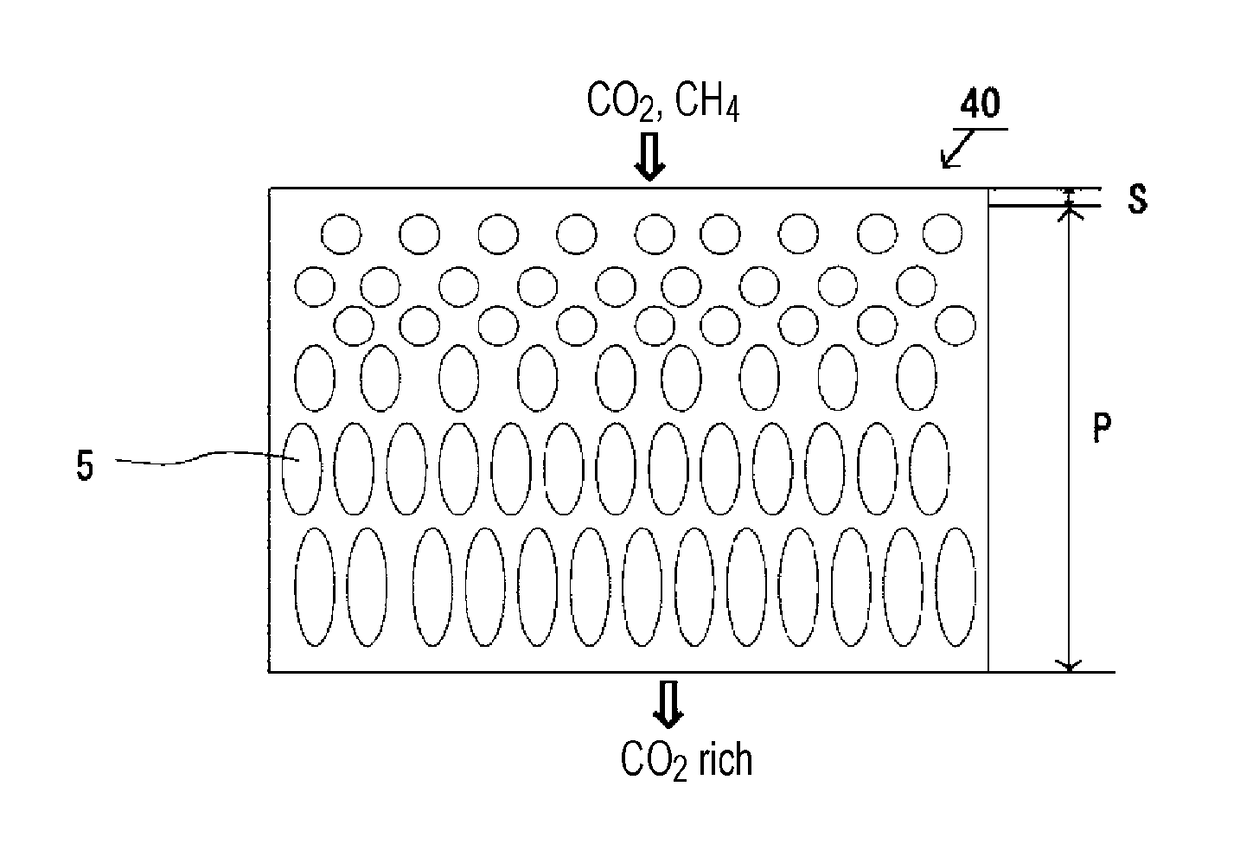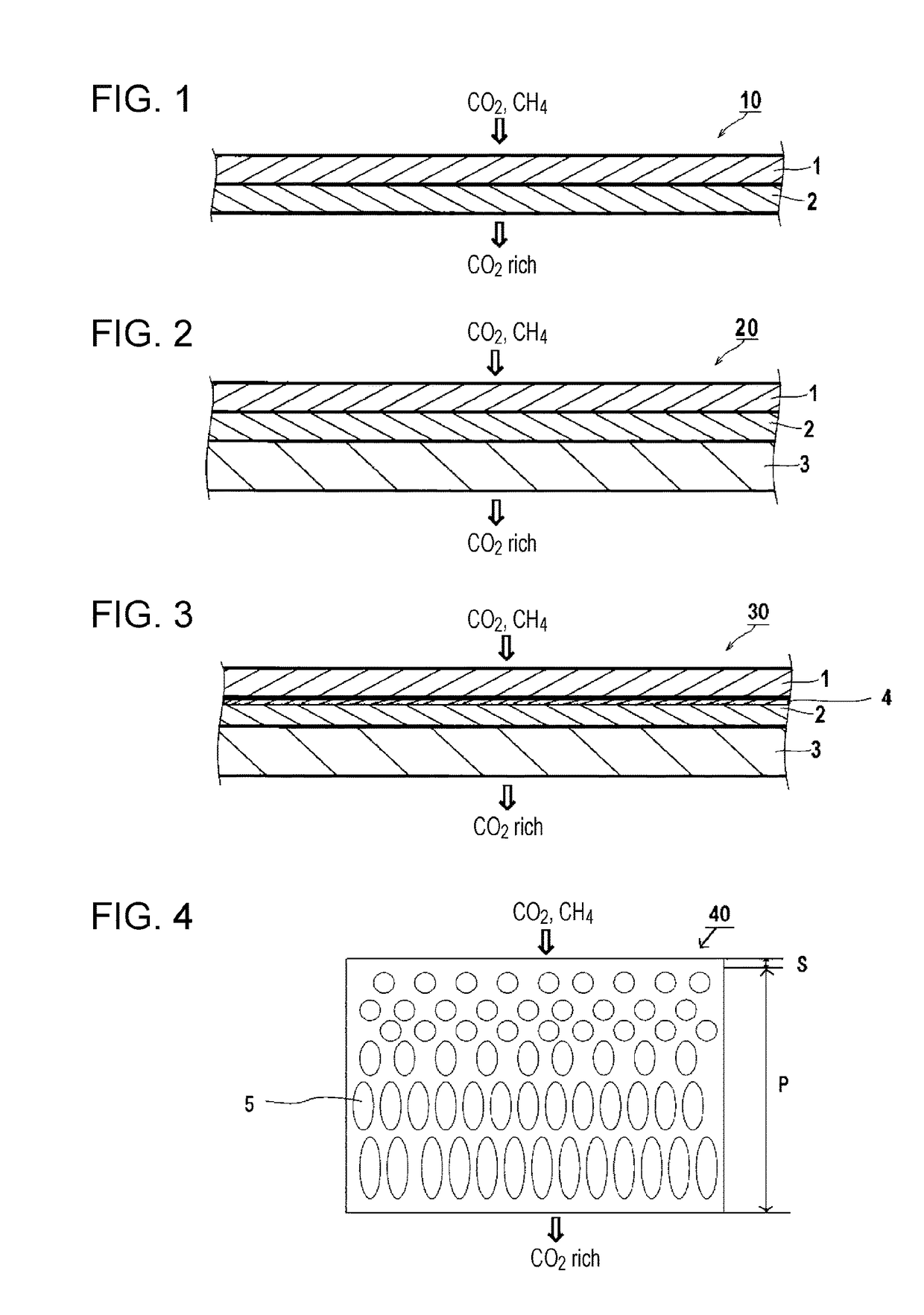Gas separation membrane, gas separation module, gas separation apparatus, gas separation method, and method for producing asymmetric gas separation membrane
a gas separation membrane and gas separation module technology, applied in the direction of gaseous fuels, separation processes, membranes, etc., can solve the problems of significant decrease in gas separation performance, difficult to prevent plasticization of membranes, and rubbing of defects, so as to achieve good gas separation selectivity and good gas separation performance. , good gas permeability
- Summary
- Abstract
- Description
- Claims
- Application Information
AI Technical Summary
Benefits of technology
Problems solved by technology
Method used
Image
Examples
example 1
Preparation of Asymmetric Membrane (Metal Crosslinking)
[0204]To 0.5 g of cellulose acetate (trade name: L-70, available from Daicel Corporation, acetylation degree 0.55, where the term “acetylation degree” refers to a weight percentage of bonded acetic acid per unit weight) serving as a cellulose resin, a mixture of 2.5 g of methyl ethyl ketone, 2.5 g of N,N-dimethylformamide (DMF), and 0.6 g of n-butanol was added to dissolve the cellulose acetate. Subsequently, 0.015 g of tris(2,4-pentanedionato)aluminum(III) (aluminum acetylacetonate) (0.046 mmol, available from Tokyo Chemical Industry Co., Ltd., Product No.: A0241) was added as a crosslinking agent to the resulting solution. The solution was filtered with a PTFE microfiltration membrane having a pore size of 5.0 μm to prepare a dope solution.
[0205]A polyester nonwoven fabric (available from Awa Paper Mfg. Co., Ltd., thickness: 95 μm) was placed on a clean glass plate (10 cm in length×10 cm in width×1 mm in thickness), and the do...
examples 2 to 24
Preparation of Asymmetric Membranes (Metal Crosslinking)
[0206]Asymmetric membranes (gas separation membranes) were prepared as in Example 1 except that, in Example 1, the cellulose resin was changed as described in Table 1, the type and the amount of crosslinking agent added were changed as described in Table 1, and the DMF was changed to the organic solvents described in Table 1.
example 25
Preparation of Asymmetric Membrane (Crosslinking by Reaction between Functional Groups)
[0207]To 0.5 g of cellulose acetate (trade name: L-70, available from Daicel Corporation, acetylation degree 0.55, where the term “acetylation degree” refers to a weight percentage of bonded acetic acid per unit weight), a mixture of 2.5 g of methyl ethyl ketone, 2.5 g of N,N-dimethylformamide, and 0.6 g of n-butanol was added to dissolve the cellulose acetate. Subsequently, 0.05 g of ethyl chloroformate (0.46 mmol, available from Tokyo Chemical Industry Co., Ltd., Product No.: C0177) was added to the resulting solution. The solution was filtered with a PTFE microfiltration membrane having a pore size of 5.0 μm to prepare a dope solution.
[0208]A polyester nonwoven fabric (available from Awa Paper Mfg. Co., Ltd., thickness: 95 μm) was placed on a clean glass plate (10 cm in length×10 cm in width×1 mm in thickness), and the dope solution was further extended on the nonwoven fabric in an environment ...
PUM
| Property | Measurement | Unit |
|---|---|---|
| Fraction | aaaaa | aaaaa |
| Percent by mass | aaaaa | aaaaa |
| Thickness | aaaaa | aaaaa |
Abstract
Description
Claims
Application Information
 Login to View More
Login to View More - R&D
- Intellectual Property
- Life Sciences
- Materials
- Tech Scout
- Unparalleled Data Quality
- Higher Quality Content
- 60% Fewer Hallucinations
Browse by: Latest US Patents, China's latest patents, Technical Efficacy Thesaurus, Application Domain, Technology Topic, Popular Technical Reports.
© 2025 PatSnap. All rights reserved.Legal|Privacy policy|Modern Slavery Act Transparency Statement|Sitemap|About US| Contact US: help@patsnap.com



